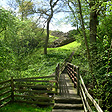HEXHAM ABBEY
Old Saxon Days to Present Market Days
 The
City of Hexham in Northumberland England has been a thriving market
town since Saxon times. Many
Roman era stones make up the buildings
of Hexam and Hexam Abbey, most probably gathered from nearby Hadrian’s
Wall and its forts, abandoned by the Romans when the empire ultimately
imploded (see Hadrian's
Wall). Hexham was founded as a center
of Christianty by Saxon Queen Etheldreda the wife of the King of Northumberland,
gifting the
lands
to Wilfred the
Bishop of York for establishing regious center. The earliest church
of St. Andrew was built on the Hexam Abbey site in 670AD as a Benedictine
monastery.
The
church
became
a Cathedral
in 681 for 140 years until the invasions of the Vikings. In 1113 the
church was reformed as an Augustinian priory in it's current configuration
with
the chancel
and trancept built about 1212 under King John (See Knaresborough
Castle Ruins). The cloisters of the monastery and lodgings
of the canons are gone now, but Hexam Abbey remains the active parish
church of Hexham to this
day. Hexam played a role in the Scottish boarder wars of Edward II and Edward III.
The
City of Hexham in Northumberland England has been a thriving market
town since Saxon times. Many
Roman era stones make up the buildings
of Hexam and Hexam Abbey, most probably gathered from nearby Hadrian’s
Wall and its forts, abandoned by the Romans when the empire ultimately
imploded (see Hadrian's
Wall). Hexham was founded as a center
of Christianty by Saxon Queen Etheldreda the wife of the King of Northumberland,
gifting the
lands
to Wilfred the
Bishop of York for establishing regious center. The earliest church
of St. Andrew was built on the Hexam Abbey site in 670AD as a Benedictine
monastery.
The
church
became
a Cathedral
in 681 for 140 years until the invasions of the Vikings. In 1113 the
church was reformed as an Augustinian priory in it's current configuration
with
the chancel
and trancept built about 1212 under King John (See Knaresborough
Castle Ruins). The cloisters of the monastery and lodgings
of the canons are gone now, but Hexam Abbey remains the active parish
church of Hexham to this
day. Hexam played a role in the Scottish boarder wars of Edward II and Edward III.
 Some
of the important features of this early Gothic architecture Abbey are
the crypt dating
from the 7th Century beginnings once
containing the relics of St. Andrew, which since had been covered
by later constructions and rediscovered in the 1700s, the Frith Stool
a 7th Century Bishop’s throne carved from a single stone block,
a Chalace dating from Anglo-Saxon times, and a rare set of night stairs
used by church canons to climb to the choir of singing Nocturns, and
the best preserved 15th Century wood painting panels depicting the “Dance
of Death” an allegory of Death in the form of a skeleton dancing
with the pope and kings.
Some
of the important features of this early Gothic architecture Abbey are
the crypt dating
from the 7th Century beginnings once
containing the relics of St. Andrew, which since had been covered
by later constructions and rediscovered in the 1700s, the Frith Stool
a 7th Century Bishop’s throne carved from a single stone block,
a Chalace dating from Anglo-Saxon times, and a rare set of night stairs
used by church canons to climb to the choir of singing Nocturns, and
the best preserved 15th Century wood painting panels depicting the “Dance
of Death” an allegory of Death in the form of a skeleton dancing
with the pope and kings.
 Extensive
reconstructions were made on Hexham Abbey in the early 1800’s
and around 1900 including redesign and replacement of the stained glass
windows, including the unique style long thin lancet windows which characterize
Hexam Abbey. A turret clock made by clockmaker John Moore of Clerkenwell
was added in 1921. The Abbey stands on the high point of the old town
directly on the market square of Hexam which is still a popular spot
for crafts, food, and bargain shopping on weekend market days harking
back to the middle-ages.
Extensive
reconstructions were made on Hexham Abbey in the early 1800’s
and around 1900 including redesign and replacement of the stained glass
windows, including the unique style long thin lancet windows which characterize
Hexam Abbey. A turret clock made by clockmaker John Moore of Clerkenwell
was added in 1921. The Abbey stands on the high point of the old town
directly on the market square of Hexam which is still a popular spot
for crafts, food, and bargain shopping on weekend market days harking
back to the middle-ages.
There are 23 churches in the Hexam Parish covering 400 square miles of the Northern Pennines and Tynedale among the quiet hamlets, many originally dating from the early 13th century, most rebuilt in the 19th century, ideal for church and graveyard touring on a northerly visit the Northumberland after hiking Hadrian’s Wall. Consult the Parish for events. © Bargain Travel Europe
Find the best travel deals in Northumberland
Web Info
Hexham Abbey
These articles are copyrighted and the sole property of Bargain Travel Europe and WLPV, LLC. and may not be copied or reprinted without permission.
See Also:
LANGLEY CASTLE HOTEL & RESTAURANT




